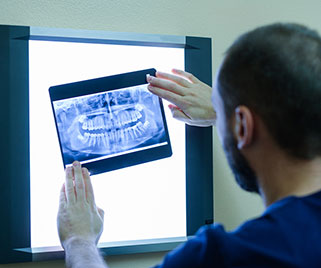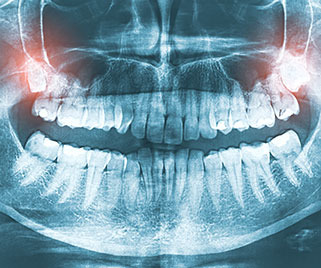Wisdom Teeth
Wisdom Teeth Removal Melbourne Victoria
Wisdom teeth or third molars sometimes need to be extracted because they do not fit into the available space in the mouth. This can lead to crowding of teeth or gum infections. An OPG x-ray will reveal the relationship of the wisdom teeth to their surrounding structures.

To Keep or Not to Keep: Wisdom Teeth Removal in Melbourne
Wisdom teeth are the last teeth to erupt usually between the ages of 17 and 25 years. They develop behind the 2nd molar tooth and have no deciduous predecessor. With sufficient space they erupt into a favourable position in alignment with the other dentition. However, if they are impacted an x-ray will assist your dentist in assessing their potential for harm.
What is an Impacted Wisdom Tooth?
A tooth becomes impacted due to lack of space in the dental arch in its eruption path. It is therefore impeded by gum, bone or another tooth. Lack of space occurs because our jaws have become smaller through evolution and the size of our teeth has not decreased much.

OVER 40 YEARS EXPERIENCE.
What are the Indications for Removing Wisdom Teeth?
Wisdom teeth generally cause problems when they erupt partially through the gum. The most common reasons for removing them are:
Decay
Saliva, bacteria and food particles can collect around an impacted wisdom tooth, causing it, or other teeth to decay. It is very difficult to remove such decay. Pain and infection will usually follow.

Gum Infection (Pericoronitis)
When a wisdom tooth is partially erupted food and bacteria collect under the gum causing a local infection. This may result in bad breath, pain, swelling and trismus (inability to open the mouth fully). This infection can spread to involve the ear, cheek and neck. Once the initial episode occurs, each subsequent attack becomes more frequent and more severe.
Pressure Pains
Pain may also come from the pressure of the erupting wisdom tooth against other teeth. In some cases this pressure may cause the erosion of these teeth.
Orthodontic Reasons
Many younger patients have had prolonged orthodontic treatment to straighten teeth. Wisdom teeth may cause movement of teeth particularly the front teeth when they try to erupt and this will compromise the orthodontic result.
Prosthetic Reasons
Patients who are to have dentures should have any wisdom tooth removed. If a wisdom tooth erupts beneath a denture it will cause severe irritation and if removed, the patient will need to have a new denture constructed, as the shape of the gum will have changed.
Cyst Formation
A cyst (fluid filled sac) can develop from the soft tissue around an impacted wisdom tooth. Cysts cause bone destruction, jaw expansion and displacement or damage to nearby teeth. The removal of the tooth and cyst is necessary to prevent further bone loss. Rarely, tumours may develop within these cysts or the jaw may fracture spontaneously if the cyst grows very large.
Why Should an Impacted Wisdom Tooth be Removed if it hasn’t Caused any Trouble?
Impacted wisdom teeth are almost certain to cause problems if left in place. This is particularly true of the lower wisdom teeth. Such problems may occur suddenly, and often at the most inconvenient times.
When is The Best Time to have my Wisdom Teeth Removed?
It is now recommended by specialists that impacted wisdom teeth be removed between the ages of 14 to 22 years if it predicted that they are likely to cause harm at some time in the future. Surgery is technically easier and patients recover much quicker when they are younger. What is a relatively minor operation at 20 can become quite difficult in patients over 40. Also, the risk of complications increases with age, and the healing process is slow.
Should a Wisdom Tooth be Removed When an Acute Infection (Pericoronitis) is Present?
Generally, no. Surgery in the presence of infection can cause infection to spread and become more serious. Firstly, the infection must be controlled by local oral hygiene, antibiotics and sometimes the extraction of the opposing wisdom tooth.
The Pro’s and con’s of Wisdom Tooth Removal Melbourne
Some pro’s of removing wisdom teeth:
- Wisdom teeth may be hard to access with your toothbrush or floss. Over time, the accumulation of bacteria, sugars and acids may cause a cavity to form in the tooth. If it is not restored with a filling, the cavity may spread and destroy more tooth structure causing severe consequences to the tooth and surrounding supportive structures.
- Due to the difficulty of keeping these teeth clean with your daily home care (brushing and flossing), bacteria and food debris remaining on the wisdom teeth may present a foul smell-causing bad breath.
- A wisdom tooth that is still under the gums in a horizontal position (rather than a vertical position) may exert pressure to the surrounding teeth, causing crowding and crooked teeth. This also may occur if there is not enough space in the mouth for the wisdom tooth. This may warrant braces to repair the damage.
- A wisdom tooth that is still under the gums may become irritated. The gum tissue that is over the tooth may harbour food debris and bacteria that gets trapped under the gum, resulting in an infection in the gums.
Some Con’s of Removing the Wisdom Teeth:
- Depending on the size, shape, and position of the tooth, removal can vary from a simple extraction to a more complex extraction. With a simple extraction, there is usually little swelling, bruising and/or bleeding. More complex extraction will require special treatment, which may result in more bruising, swelling and bleeding. However, your dentist will provide you with post treatment instructions to minimize these side effects.
- Following an extraction, a condition called “dry socket” may occur. If the blood clot that formed in the extraction area becomes dislodged, it exposes the underlying bone. This condition is very painful but resolves after a few days. It is preventable by following the post-treatment instructions provided by your dental professional.
- The longer you wait and the older you get, there is the potential for more problems to occur. This is because as you get older, the bone surrounding the tooth becomes denser, making the tooth more difficult to remove. The healing process may also be slower.
Wisdom Teeth Removal Melbourne
The Carnegie Dental Group is now open late nights! We are opened until 7pm on Tuesdays & Wednesdays.
Request an Appointment
Fill out the form below and we will contact you during our working hours. If you have a dental emergency, please call (03) 9571 9016. Urgent care is provided usually on the same day.
 (03) 9571 9016
(03) 9571 9016 Find Us
Find Us